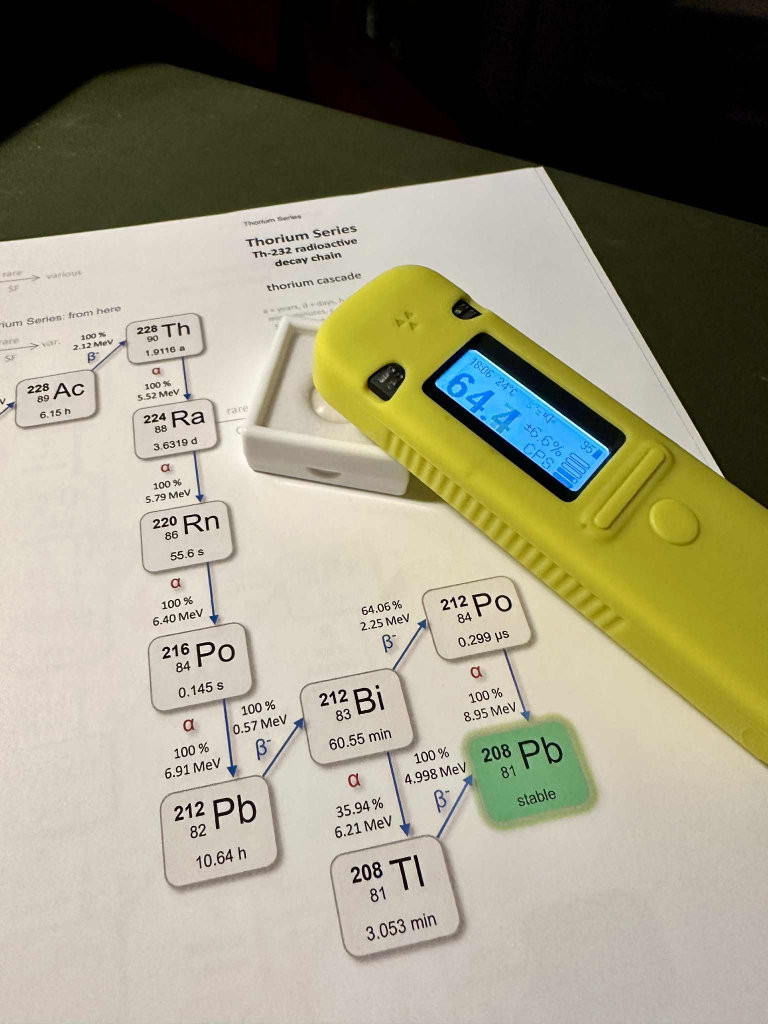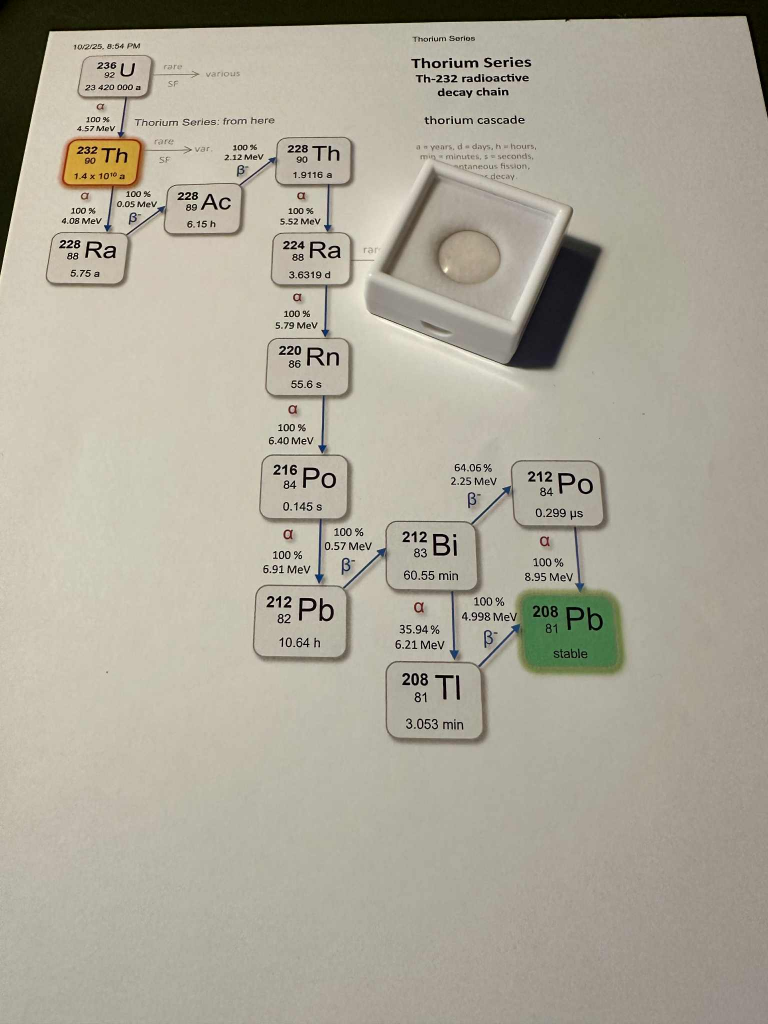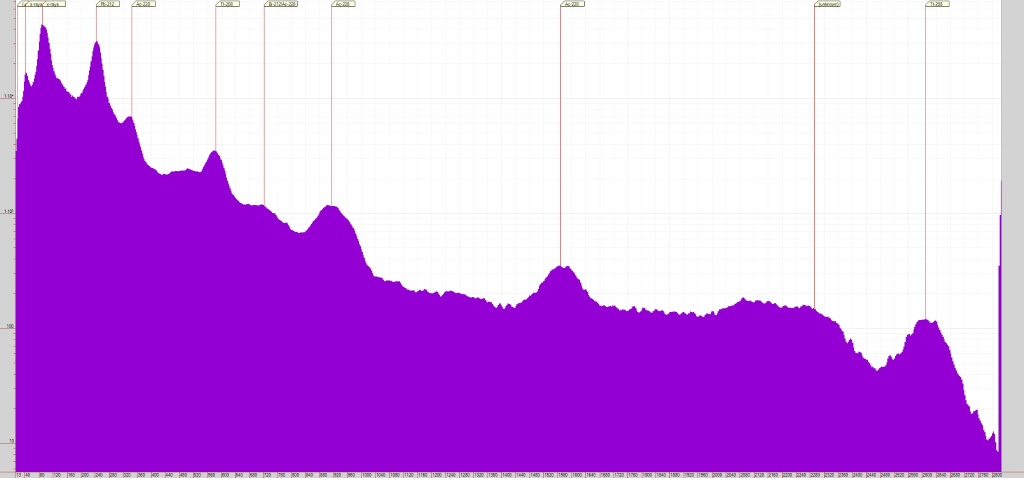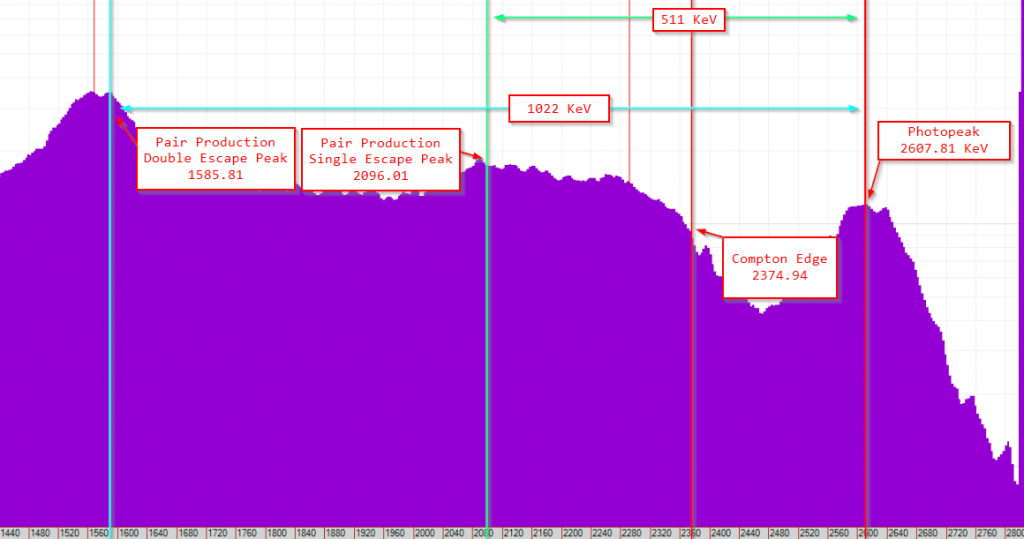
Since purchasing the Radiacode 110, I have been learning more about radioactivity. Specifically: decay chains. Since learning about decay chains, I want to capture the isotopes from these decay chains via gamma-ray spectroscopy.
There are four major decay chains: Thorium, Uranium, Actinium, and Neptunium. Actinium and Neptunium decay chains are not as easily obtained as Thorium and Uranium so I concentrated on the latter two. This first article discusses my attempt at gathering spectra on the Thorium-232 Chain.
“Dark Frames”
In preparation of gathering the spectra, I wanted to get a good background radiation profile in the area where I will be gathering the spectra on my specimens. Background radiation is always around us coming from mostly natural sources. This includes cosmic rays, Radon Gas, soil, building materials, food/water, and even ourselves! The idea is to get a long integration of background radiation so it can be subtracted from the spectra of your sample. This gives you a cleaner signal with a better SNR.
This is very similar to what we do in astroimaging: we take dark frames. I see parallels between astroimaging and gathering gamma-ray spectra. We subtract the dark frames from the light frames to get a better SNR.
Overnight, I collected about 10 hours of natural background radiation to prepare to gather the spectra of the decay chains of my samples.
Thorium-232 Chain

Thorium-232 is the most stable isotope of Thorium with a half-life of 14 billion years so it has been around a while (about the same as the age of the Universe). Thorium is named after the Norse God of Thor, it was discovered in 1828. You can find Thorium in commercial products like TIG welding electrodes and lantern mantles (although the mantles are not manufactured anymore due to the potential health hazards). The sample I am using is a thoriated lens that I obtained from Geigercheck.

Thorium-232 is a 4n decay chain. What this means is when you divide the atomic weight by 4, the remainder is always zero in the decay chain. Pb-208 belongs to the 4n series as its mass can be divided completely. Pb-208 is the final decay product of the Thorium-232 4n chain.
Looking at the results
I am using this as a reference spectra for Th-232 (source):

After running for over 10 hours, I started looking at the gathered spectra. Here is my spectra that I obtained (minus background):

After filtering out isotopes that would not be present (like Pb-214 that the software identified), I compared my peak detections to the spectrum results from the reference:


Based on the peaks in the spectra, I am seeing Ac-228, Bi-212, Pb-212, and Tl-208 emissions. All isotopes from the Thorium-232 chain!




Compton Edge
Doing some research, I found this article on Wikipedia and this forum post about the Compton Edge. Using the simplified formula from the post, I calculated what the Compton Edge is for my spectra: 2374.94 KeV
E_{compton} = E_γ (1-\frac{1}{1+ \frac{2E_γ}{E_e} })E_{compton} = 2607.81 keV (1-\frac{1}{1+ \frac{2*2607.81 keV}{511keV} }) ≈ 2374.94keVPair Production
Pair production is when a photon at high energies (MeV) form a subatomic particle and its antiparticle. In this case, I am looking for electron and positron pairs. Based on what I read, the electron mass energy equivalent is ≈ 511 KeV and when a photon is near the atomic nucleus, the energy of the photon can be converted into an electron-positron pair. If one of those pairs escapes, the energy is ≈ 511 KeV. If both escape, it is ≈ 1022 KeV. So on a gamma-ray spectrum, there will be peaks at 511 and 1022 KeV to the left of the Photopeak.
2607.81 KeV - 511 KeV = 2096.81 KeV
2607.81 KeV - 1022 KeV = 1585.81 KeV
Calculating this gives me a Single Escape Peak at 2096.81 KeV and a Double Escape Peak of 1585.81 KeV.
Using this information, I created the following diagram:

Pair Annihilation
Looking more into my spectra, I noticed a small peak around 511 KeV which would correspond to Electron-Positron Pair Annihilation. When the pair annihilate each other, 2 or more photons are emitted at 511 KeV which will display in the spectra.

That was fun!
This experiment was very enjoyable as I have learned a great deal about gamma-ray spectra, decay chains, and measurement phenomena when dealing with detecting gamma-rays in a scintillator. Being an amateur scientist, this was rewarding as I learn more about the world around us.
Next, I will work on the Uranium-238 chain.
